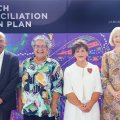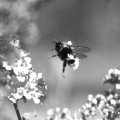They are not little green men but, according to numerous unrelated accounts, they do apparently share many similar characteristics.
They have large heads, black almond-shaped eyes, no ears, slit mouths, very thin bodies of indeterminate gender, and grey or white skin.
These are the creatures described by people claiming to have seen or been abducted by aliens, a phenomenon now being studied by an honours student at the University of Queensland.
A childhood fascination with Unidentified Flying Objects (UFOs) has developed into a serious academic pursuit for Adam Dodd, of the English Department's Media and Cultural Studies Centre.
"I used to get UFO books from the library as a kid and was also interested in unexplained things such as ghosts and creatures like the Loch Ness monster," Mr Dodd said.
"As I grew older I became increasingly intrigued why these phenomena were not being given more attention by academics."
Mr Dodd is now doing something about that. He has extensively researched and written about UFOs and is currently working on a thesis entitled Alien Abduction: Anatomy of a Postmodern Myth.
His interest lies in exploring the influence of expectation and imagination upon our perception of events, and what the emergence of alien abduction signifies in western culture on the eve of the new millennium.
Without declaring himself either a sceptic or a believer, Mr Dodd has nonetheless reached two conclusions. He believes people claiming alien abduction are mostly reporting what they honestly think happened; and that in all likelihood there is something out there we do not - and may never - fully understand.
He said reported abductions were usually from people's beds or cars. They were taken to an unfamiliar environment - which might or might not be inside a UFO - where the normal laws of physics, time and space did not apply.
The first such case, involving a couple in the United States, was reported in 1963, and there had been a steady increase in numbers since then. Indeed, Mr Dodd said the number of incidents was probably much higher than ever reported.
While reported abductions were mainly in the West, including Australia, there had been cases in South America and Africa. However, most reports came from the United States where research was more advanced and the whole debate more socially acceptable.
Cynics have asked why aliens would bother travelling many light years through countless galaxies just to abduct a farmer from a remote and rustic corner of rural America.
But Mr Dodd said it was not just country people who had been abducted though they certainly had less to lose by going public with their claims. He said speaking out about these experiences took courage and conviction, often in the face of ridicule and scorn which could be especially damaging to those in high profile positions.
Despite that, claimed abductions had come from quite a cross-section of people in various walks of life and a recent case still under investigation, and for which there was a very credible witness, was from an apartment in New York.
He said films such as The X-Files, Close Encounters of the Third Kind and Independence Day often created a climate in which people felt less intimidated about coming forward with their reports.
Mr Dodd said society needed to shed some of its preconceptions before looking at this phenomenon. For example, there was no logical reason why a person's status or occupation should be important to visiting aliens.
Similarly, we needed to adopt a more lateral view of the so-called laws of physics when considering things like time and distance in relation to possible alien travel.
Mr Dodd said looking back 200, 100 or even just 50 years, showed how things once believed impossible and beyond the laws of physics were now accepted as commonplace. For example, sending images and sound instantly around the world, flying, the speed of travel, and space flight.
"These and many other things we now take for granted were once derided by scientists and other so-called experts. If that teaches us anything it should be at least to keep an open mind about the possibility of aliens visiting earth," he said.
Researchers studying the claimed abductions had uncovered little hard evidence and Mr Dodd said one aspect of his thesis was examining how reported abductions challenged accepted ways of knowing things.
"I'm interested in how we as a society decide what's real and what is not, and specifically how that decision is often dominated by a very small group of people. Once that was the church - today it's the accepted scientific establishment," he said.
Mr Dodd graduated bachelor of arts in media studies and modern history in 1996 and as part of his degree submitted a research paper on the politics of the UFO phenomenon in Cold War America.
Mr Dodd is also a trainee field investigator for Texas-based international civilian research organisation the Mutual UFO Network which, with more than 3000 members, is the largest such organisation in the world.
For further information, contact Adam Dodd (telephone 3846 3947 a/h).



